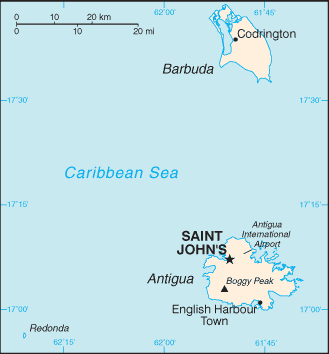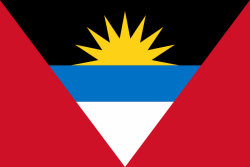Antigua and Barbuda
Related Categories:
 Antigua and Barbuda - Fotw
Antigua and Barbuda - FotwThe sun represents the dawning of a new era; red - the energy of the people; blue - hope; black, the African ancestry of the people.
www.fotw.us/flags/ag.html Antigua and Barbuda - wikipedia.org
Pre-ceramic Amerindians were the first to inhabit the islands of Antigua and Barbuda in 2400 BC.
en.wikipedia.org/
Antigua was first inhabited by the Siboney ("stone people"), whose settlements date at least to 2400 BC. The Arawaks--who originated in Venezuela and gradually migrated up the chain of islands now called the Lesser Antilles--succeeded the Siboney. The warlike Carib people drove the Arawaks from neighboring islands but apparently did not settle on either Antigua or Barbuda.
Christopher Columbus landed on the islands in 1493, naming the larger one "Santa Maria de la Antigua." The English colonized the islands in 1632. Sir Christopher Codrington established the first large sugar estate in Antigua in 1674, and leased Barbuda to raise provisions for his plantations. Barbuda's only town is named after him. Codrington and others brought slaves from Africa's west coast to work the plantations.
Antiguan slaves were emancipated in 1834 but remained economically dependent on the plantation owners. Economic opportunities for the new freedmen were limited by a lack of surplus farming land, no access to credit, and an economy built on agriculture rather than manufacturing. Poor labor conditions persisted until 1939 when a member of a royal commission urged the formation of a trade union movement.
www.state.gov/r/
Introduction
About
Contact
Symbols in The News
Interpret this Symbol
AAC
African
AI
Alchemy
Alphabets
Ancient
Animal Symbolism
Architecture
Art
Articles
Astrology
Baha'i
Blissymbolics
Blueprint Symbols
Buddhist
Celtic Symbols
Cemetery
Chinese Symbols
Christian
Circle
City
Codes
Color
Conlangs
Crop Circles
Danger
Da Vinci Code
Designing Logos
Dictionaries
Dreams
Education
Egyptian Symbols
Electrical
Emoticons
Find Images
Fonts
Food
Fraternity
Hamsa
Healing
Heraldry
Hermetic
Highway Signs
Hindu
History
Hobo
Holiday
Icons
iConji
Islamic
Jain Symbols
Japanese, Kanji
Jewish
Justice
Law
Literary Symbolism
Mandalas
Map
Masonic
Math, Number
Meaning of Names
Medical
Middle East
Military
Miscellaneous
Money
Music
Mythology
Native American
Playing Cards
Power
Psychology
QiQiiKhu
Reiki
Religious
Runes, Norse
Sacred Geometry
Scientific
Science Fiction
Sorority
Sports
Symbols in the News
Tattoos
ThirteenSymbols
Tree of Life
Ursprache
Videos
Visual Languages
Weather
Web Codes
Wicca
Words
Writing Systems
Braille
Coinherence
Coptic
Cuneiform
Easter Island
Etruscan
Happy Human
Hebrew
Kokopelli
Linear B
Lotus
Love Symbols
Mandorla
Moon Alphabet
Nine Pointed Star
Om
Oz
Phonetic
Scarab Beetle
Silent
Theosophy
Unifon
About
Contact
Symbols in The News
Interpret this Symbol
AAC
African
AI
Alchemy
Alphabets
Ancient
Animal Symbolism
Architecture
Art
Articles
Astrology
Baha'i
Blissymbolics
Blueprint Symbols
Buddhist
Celtic Symbols
Cemetery
Chinese Symbols
Christian
Circle
City
Codes
Color
Conlangs
Crop Circles
Danger
Da Vinci Code
Designing Logos
Dictionaries
Dreams
Education
Egyptian Symbols
Electrical
Emoticons
Find Images
Fonts
Food
Fraternity
Hamsa
Healing
Heraldry
Hermetic
Highway Signs
Hindu
History
Hobo
Holiday
Icons
iConji
Islamic
Jain Symbols
Japanese, Kanji
Jewish
Justice
Law
Literary Symbolism
Mandalas
Map
Masonic
Math, Number
Meaning of Names
Medical
Middle East
Military
Miscellaneous
Money
Music
Mythology
Native American
Playing Cards
Power
Psychology
QiQiiKhu
Reiki
Religious
Runes, Norse
Sacred Geometry
Scientific
Science Fiction
Sorority
Sports
Symbols in the News
Tattoos
ThirteenSymbols
Tree of Life
Ursprache
Videos
Visual Languages
Weather
Web Codes
Wicca
Words
Writing Systems
Braille
Coinherence
Coptic
Cuneiform
Easter Island
Etruscan
Happy Human
Hebrew
Kokopelli
Linear B
Lotus
Love Symbols
Mandorla
Moon Alphabet
Nine Pointed Star
Om
Oz
Phonetic
Scarab Beetle
Silent
Theosophy
Unifon

